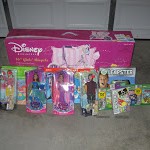
One of my goals in creating this blog has always been to help people find ways to save more money, cut their budgets, and if needed, get out of debt! My goal this year is to bring you a different “themed” series each month with ideas for cutting your expenses in specific areas. This month, my focus will be on “31 Ways to Save in 2011” and I’ll give you simple ideas for making a little extra money on the side along with ideas for how you can cut your current expenses. I hope you’ll join me on this journey. Start tracking what you’re saving right now – there is a great free downloadable spreadsheet here that you can use to track your shopping savings! If you’ve got ideas about how you can save more this year, please link up below and share.
My first suggestion on your journey to savings is to create a budget. When you create a budget, you know exactly where your money is going which also helps you to pinpoint where your “leaks” are so you know exactly where you need to make cuts.
My husband and I took Dave Ramsey’s Financial Peace University class almost two years ago and it was truly life-changing. If you are able to, I recommend checking it out. It’s often offered at local churches and the fee is normally $99, which includes all of the materials and thirteen classes.
Here are some of the things that have worked for us in creating a budget!
Find out where your money is going
Spend a few weeks or even a month tracking EVERY penny you spend (yes, that’s right EVERY penny…even that change you spend here and there at the vending machines at work should be included). This will help put you back in touch with your finances and will help you understand where your are spending your money. Many times, it is pretty shocking to realize how much you have been spending and what you have been spending it on.
Create a budget
Once you have an idea about where your money is going, you can begin to create your budget. I think one of the biggest mistakes people make when they are creating a budget is that they don’t account for all of the categories where they actually spend money, which inevitably leads to a budget crisis.
People typically remember the “big” things when creating their budget like: mortgage/rent, car payments, utility bills, groceries, and eating out, but often forget the “little” things like gifts, hair cuts, clothing, entertainment money, and auto or home repairs. I have heard people say that they don’t “need” some of those things, which may be true, but sooner or later, you will have to buy a birthday gift or a baby gift or a Christmas gift. Unless you cut your own hair, at some point, you will need a hair cut. Unless you sew your own clothing, you’ll probably want or need something new. And…inevitably, something will go wrong with your home or car and you’ll have expenses there. It’s better to be prepared for these things ahead of time than to be scrambling trying to find the money when the need actually arises because chances are at that point, you won’t have the money.
Some people prefer to create an Excel spreadsheet to track their budget. Others just write it on a piece of paper. There are some great free tools online to help you create a budget. Here are a few:
*Basic Budgeting Worksheet from BetterBudgeting.com
*Quickie budget and Monthly Cash Flow Planning from DaveRamsey.com (I personally use his “Gazelle budget program” for planning our budget. You can access a “lite” version or sign up for a free trial here.)
*Easy Budgeting Tools from Mint.com (you do have to register)
*Create a budget and manage your online envelope system at MySpendingPlan.com (you do have to register)
Once you’ve created your budget, stick to it!
Creating a budget isn’t the “hard” part. The hard part comes in actually sticking to the budget you’ve created. Dave Ramsey recommends a “cash only” system. For our family, one of the best moves we have made was going to a cash envelope system. Research shows that the average person spends 12-18% more when they are using “plastic” to pay for things. From personal experience, I can tell you that this is true. When you’re using plastic rather than cash you have a tendency to remove yourself from what you’re actually spending…until the bill comes in the mail, of course!
When our family switched to a cash envelope system, it was surprising that we actually had money left at the end of the month most of the time. Suddenly expenses that had seemed “important” in the past really weren’t as important when we were spending real money to pay for them.
When people are first starting out using the envelope system, I often have them ask which categories we use. We actually have quite a few envelopes, and it took some trial and error to get to the point where we are at now, but I like to know exactly where our money is going and this is what worked out best for us. Here are the categories we use:
*Allowance (this is money my kids can earn for completing weekly jobs)
*Auto repairs/maintenance (this is for things like oil changes and minor things that come up…if there is money left at the end of the month, it goes into our “sinking fund”)
*Blow money (this is money that my husband and I each get to spend on anything we want, no questions asked)
*Clothing (any money left goes into our “sinking fund’)
*Eating out/restaurants
*Entertainment
*Gifts (anything left goes into our “sinking fund”)
*Hair care
*Home repairs/maintenance (this is for things like replacing light bulbs, AC filters, etc…if there is money left at the end of the month, it goes into our “sinking fund”)
*Groceries
*Miscellaneous (this is for paper goods, diapers, etc. I look at this as my “CVS” and “Walgreens” filler money)
*Pet Care (this is for dog food and dog treats, anything left goes into the “sinking fund”)
*Prescriptions and over the counter medications
*Toiletries (this is for those little “extras” that come up ~ toothpaste, toilet paper, contact solution, etc.)
If you’re wondering what a “sinking fund” is, it’s basically money that you save for an expense that you know is going to come up. For us, we have sinking funds for things like auto registration/repairs, Christmas, vacation, clothing, escrow/property taxes/home owner’s association fees, and home repairs.
We do not pay for our gas using cash. We use our debit cards for this for convenience (it’s no fun to drag two small kids into the gas station and wait in line to pay cash and then drag them back out and get them strapped back into the car). We also use a rewards credit card to pay for our routine monthly expenses (utilities, etc.) and then we pay it off at the end of the month.
We do not carry our envelopes with us all of the time. We keep them locked up and only pull cash out when we know that we’re going somewhere and will need it. If we don’t have enough cash for something, we either go home and get more (it’s amazing, though, how you start to re-evaluate whether you really “need” something when you’re making that extra trip) or we don’t buy it.
If you’re looking to make some really trendy envelopes for yourself, there’s a really awesome template and tutorial here.
Revisit your budget
At the end of a budgeting period (we budget from the 15th to the 14th of each month rather than from the start of a month because that’s what worked out best with the way we get paid), make sure that you revisit your budget, especially in the beginning, so you can figure out what works and doesn’t work. As you create your budget each month, make sure you consider special circumstances that may take place during that month (for example, school supplies during August or September).
I promise you that knowing where your money is going and accounting for every penny really will make a difference! It’s amazing how you become more conscientious about your spending when you know where your money is going!
*This post may contain affiliate links. Please refer to my disclosure policy for more information.














Thanks for all the info, especially about the Gazelle budgeting tool from DR. I signed up for my free trial and I already love it. My budget tool before was really tedious and therefore, didn't get used at it's full potential so I'm thinking this new one will help motivate me, thanks again!
I know the Gazelle budgeting tool has a fee (after the free trial), but it was worth every penny to me! I am on my second renewal. It makes budgeting SOOOO easy!!